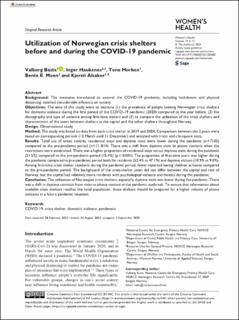| dc.description.abstract | Background:
The measures introduced to control the COVID-19 pandemic, including lockdowns and physical distancing, exerted considerable influence on society.
Objectives:
The aims of this study were to examine (1) the prevalence of people seeking Norwegian crisis shelters for domestic violence during the first period of the COVID-19 pandemic (2020) compared to the year before, (2) the demography and type of violence among first-time visitors and (3) to compare the utilization of the crisis shelters and characteristics of the users between shelters in the capital and the other shelters throughout Norway.
Design:
Observational study.
Method:
The study was based on data from each crisis shelter in 2019 and 2020. Comparison between the 2 years were based on corresponding periods (12 March until 31 December) and analysed with t-test and chi-square tests.
Results:
Total use of crises centres, residential stays and daytime visits were lower during the pandemic (n = 7102) compared to the pre-pandemic period (n = 11 814). There was a shift from daytime visits to phone contacts when the restrictions were established. There was a higher proportion of residential stays versus daytime visits during the pandemic (21.5%) compared to the pre-pandemic period (15.4%) (p ⩽ 0.001). The proportion of first-time users was higher during the pandemic compared to pre-pandemic period both for residents (52.4% vs 47.1%) and daytime visitors (10.9% vs 9.0%). Among first-time crisis shelter residents during the pandemic period, fewer reported having children at home compared to the pre-pandemic period. The background of the crisis-shelter users did not differ between the capital and rest of Norway, but the capital had relatively more residents with psychological violence and threats during the pandemic.
Conclusion:
The utilization of Norwegian crisis shelters, especially daytime visits was lower during the pandemic. There was a shift in daytime contacts from visits to phone contact at the pandemic outbreak. To ensure that information about available crisis shelters reaches the total population, these shelters should be prepared for a higher volume of phone contacts in a future pandemic situation. | en_US |

